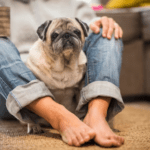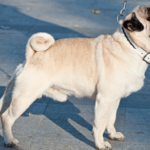Are English Bulldogs dangerous? Can they hurt you? These questions may have crossed your mind if you consider bringing one of these adorable, wrinkly-faced pups into your home. While English Bulldogs are known for their gentle and affectionate nature, it’s essential to understand their temperament and potential for causing harm. We’ll explore the truth behind whether or not English Bulldogs can genuinely hurt you. So please grab a cup of coffee, and let’s dive in.
Bulldog Temperament: Understanding Their Nature
When it comes to understanding the temperament of English Bulldogs, one word that often comes to mind is “docile.” These lovable creatures are generally known for their laid and friendly nature. They thrive on human companionship and are often called “people dogs” due to their love for attention and affection.
Yet it’s important to note that every Bulldog is unique and may exhibit individual personality traits. While most Bulldogs tend to be calm and easygoing, some can display stubbornness or assertiveness if not adequately trained or socialized. Early socialization plays a crucial role in shaping your Bulldog’s behavior.
While these traits contribute to the overall charm of English Bulldogs, responsible ownership also entails recognizing potential risks associated with any dog breed. Knowing your Bulldog’s temperament will help you understand how best to interact with them and minimize the likelihood of harmful incidents.
Understanding the nature of English Bulldogs requires acknowledging both their loving personalities and potential tendencies towards stubbornness or protectiveness. By providing proper training, socialization, and care within a safe environment, you can ensure a harmonious relationship with your beloved Bulldog companion without worrying about them causing harm.
Potential For Harm: When Bulldogs May Cause Injury

English Bulldogs are generally known for their friendly and laid-back nature, but like any other dog breed, they have the potential to cause harm in certain situations. It’s essential to understand when and why bulldogs may pose a risk of injury.
One factor that can contribute to potential harm is a bulldog’s size and strength. Despite their stout build, English Bulldogs possess significant muscular power. If they were to jump up on someone or unintentionally knock them over, it could result in injury.
To minimize the likelihood of harm from an English Bulldog, responsible ownership plays a crucial role. Ensuring proper socialization from an early age helps acclimate these dogs to different people and situations while reducing the chances of fear-based reactions.
Training is equally essential in fostering good manners and obedience in Bulldogs. Basic commands such as “sit,” “stay,” and “leave it” can prove invaluable when managing potentially risky scenarios where temptation or stress may cause undesirable behaviors.
It’s worth noting that legal considerations should also be considered regarding dog ownership responsibilities. Following local laws regarding leash requirements and containment measures protects others and safeguards your beloved pet from potential hazards outside your property.
Bite Force And Risk: Assessing The Danger Level
When assessing the potential danger of English Bulldogs, their bite force is a crucial factor to consider. While these adorable dogs may not have the most vital bite force compared to other breeds, they still possess enough power to cause injury if provoked or mishandled.
English Bulldogs are known for their strong jaws and determination. Their bite force ranges from 200,300 pounds per square inch (PSI), significantly lower than larger breeds like German Shepherds or Rottweilers. However, this doesn’t mean that Bulldogs cannot hurt you.
The risk level associated with an English Bulldog’s bite depends on temperament, training, socialization, and individual behavior. A well-socialized and trained Bulldog is less likely to exhibit aggressive behaviors or misuse its bite.
Nevertheless, it’s important not to underestimate any dog’s potential for harm. Even though English Bulldogs are generally friendly and docile companions, they can still become defensive or react aggressively when threatened or cornered.
To minimize the risk of injury from a Bulldog’s bite, owners must provide proper training and socialization from an early age. This helps them develop good manners and learn appropriate ways of interacting with people and other animals.
Responsible ownership also plays a vital role in ensuring safety around English Bulldogs. It means understanding your dog’s limitations, recognizing signs of discomfort or aggression, and taking necessary precautions when risks may be higher, such as introducing them to unfamiliar environments or interactions with small children.
While English Bulldogs have the potential to cause harm if provoked or mishandled, with responsible ownership practices in place along with adequate training and socialization efforts carried out consistently, you can significantly reduce any likelihood of experiencing adverse incidents involving your beloved bulldog companion.
Prevention and Safety: Minimizing The Risk Of Injury
When owning an English bulldog, prevention and safety should be top priorities. While these adorable dogs are generally gentle and affectionate, measures still need to be taken to minimize any potential risks of injury.
First and foremost, creating a safe environment for your Bulldog is essential. This means ensuring that your home is free from hazards such as sharp objects or toxic substances that could harm them. Keep electrical cords out of their reach, securely fence off swimming pools or other bodies of water, and provide them with a comfortable and secure living space.
Regular exercise is also vital in keeping your Bulldog physically fit and mentally stimulated. A tired dog is less likely to engage in rough play or exhibit destructive behaviors that could result in accidents.
Socialization from an early age plays a significant role in preventing aggressive behaviors towards humans or other animals. Expose your Bulldog to various environments, people, and situations so they become well-adjusted individuals who can interact appropriately with others.
Training sessions not only help establish boundaries but also promote good behavior overall. Consistency and positive reinforcement techniques will go a long way in teaching your bulldog commands like “sit,” “stay,” and “leave it.” This training can prevent situations where their actions may inadvertently cause harm.
Responsible ownership includes being aware of local pet ownership laws and understanding ethical considerations surrounding breeding practices for English Bulldogs. Ensure you obtain your furry friend from reputable breeders who prioritize the health and temperament traits necessary for this breed’s well-being.
By following these preventive measures diligently while providing a loving and structured environment, you can significantly reduce the risk of injury.
Socialization and Training: Building a Well-Behaved Bulldog
Socialization and training play a crucial role in shaping the behavior of English Bulldogs. These adorable wrinkled pups are known for being stubborn, but they can become well-behaved companions with proper socialization and training.
Starting socialization early is essential to ensure your Bulldog grows up to be friendly and confident around people and other animals. Expose them to different environments, sounds, sights, and experiences from a young age. This will help them adapt better to new situations as they grow older.
Positive reinforcement-based training methods work best for Bulldogs. They respond well to rewards such as treats or praise when they exhibit desired behaviors. Consistency is vital in training; establish clear rules and boundaries you consistently enforce.
It’s essential not to use harsh punishments or physical force during training sessions, as this can damage the trust between you and your Bulldog. Instead, focus on positive reinforcement techniques that reward good behavior.
Enrolling your Bulldog in obedience classes or working with a professional dog trainer can also be beneficial. They will guide effective training techniques while ensuring your furry friend gets social interaction.
Responsible Ownership: Legal and Ethical Considerations
Legally speaking, dog owners are often held accountable for the actions of their pets. If an English Bulldog causes harm or injury due to negligence or lack of control by its owner, there can be severe consequences. In some cases, legal action may be taken against the owner, which could result in fines or criminal charges.
Ethically speaking, owning a dog means being committed to its well-being and ensuring it does not threaten others. This includes providing proper healthcare, regular exercise, and mental stimulation through training and playtime and adhering to local laws regarding licensing and vaccinations.
To be a responsible owner of an English Bulldog:
1. Educate yourself about breed-specific traits: Understanding your Bulldog’s behavior patterns can help prevent potential harm.
2. Socialize your Bulldog from an early age: Expose them regularly to different people, animals, and environments so they learn appropriate behavior.
3. Invest time in obedience training: Teaching basic commands like sit, stay, and recall will help you maintain control over your Bulldog in various situations.
4. Provide adequate physical exercise: Regular walks or play sessions will keep your Bulldog physically fit while reducing hyperactivity that may lead them to unintentional injuries.
5. Supervise interactions with children: While generally good-natured with kids, if properly trained, don’t leave young children alone unsupervised with any dog, including an English Bulldog.
6.
Lead by example: Always show kindness, patience, and respect towards your bully because how you treat him will influence his behavior.
By following these guidelines and being a responsible owner, you can.


